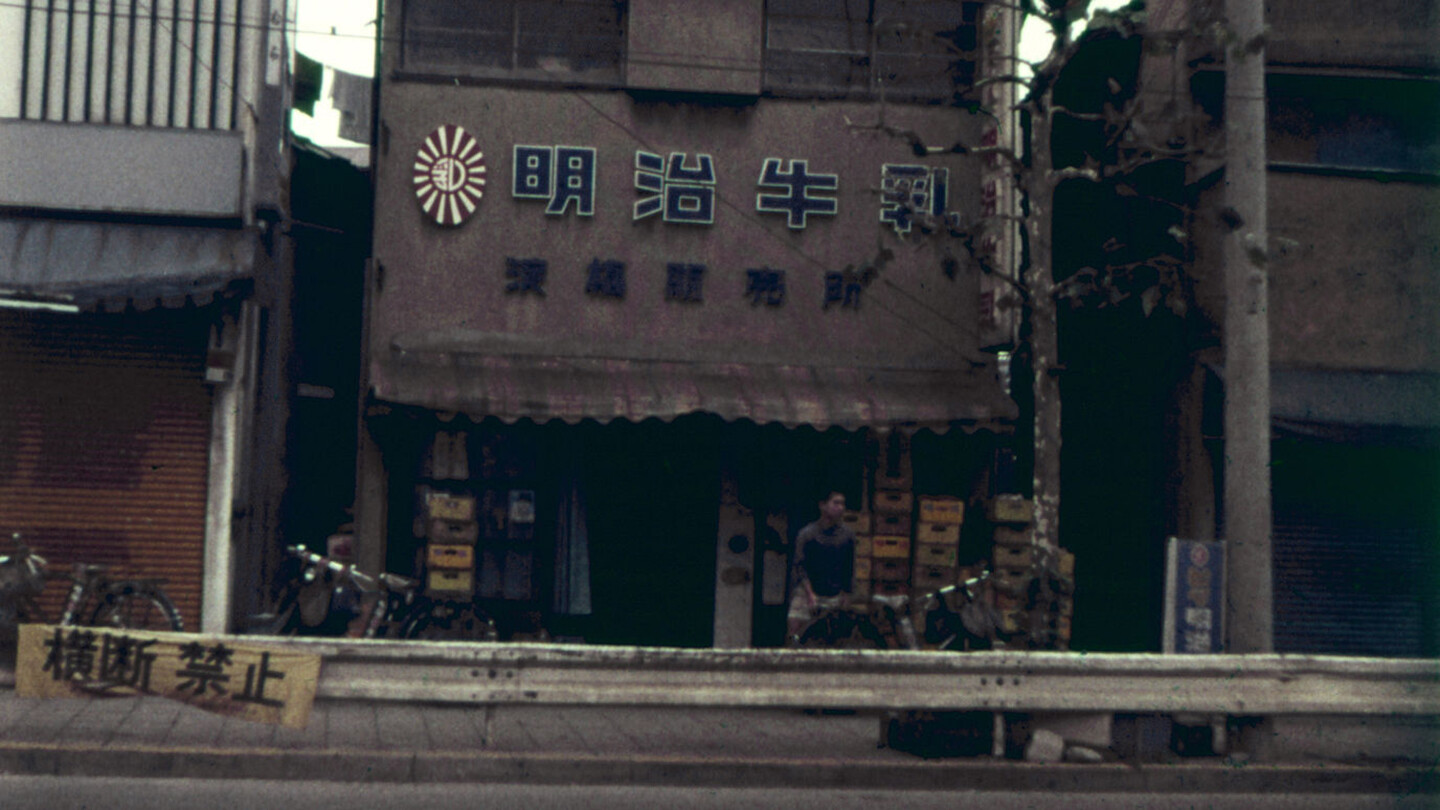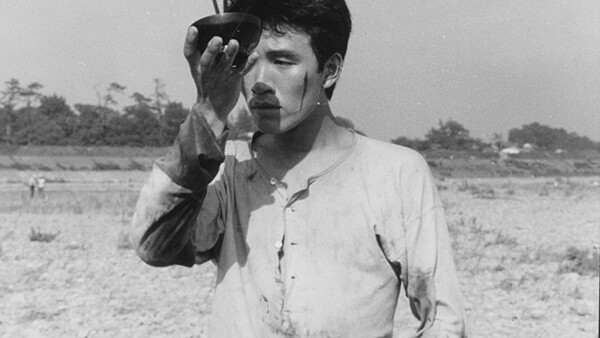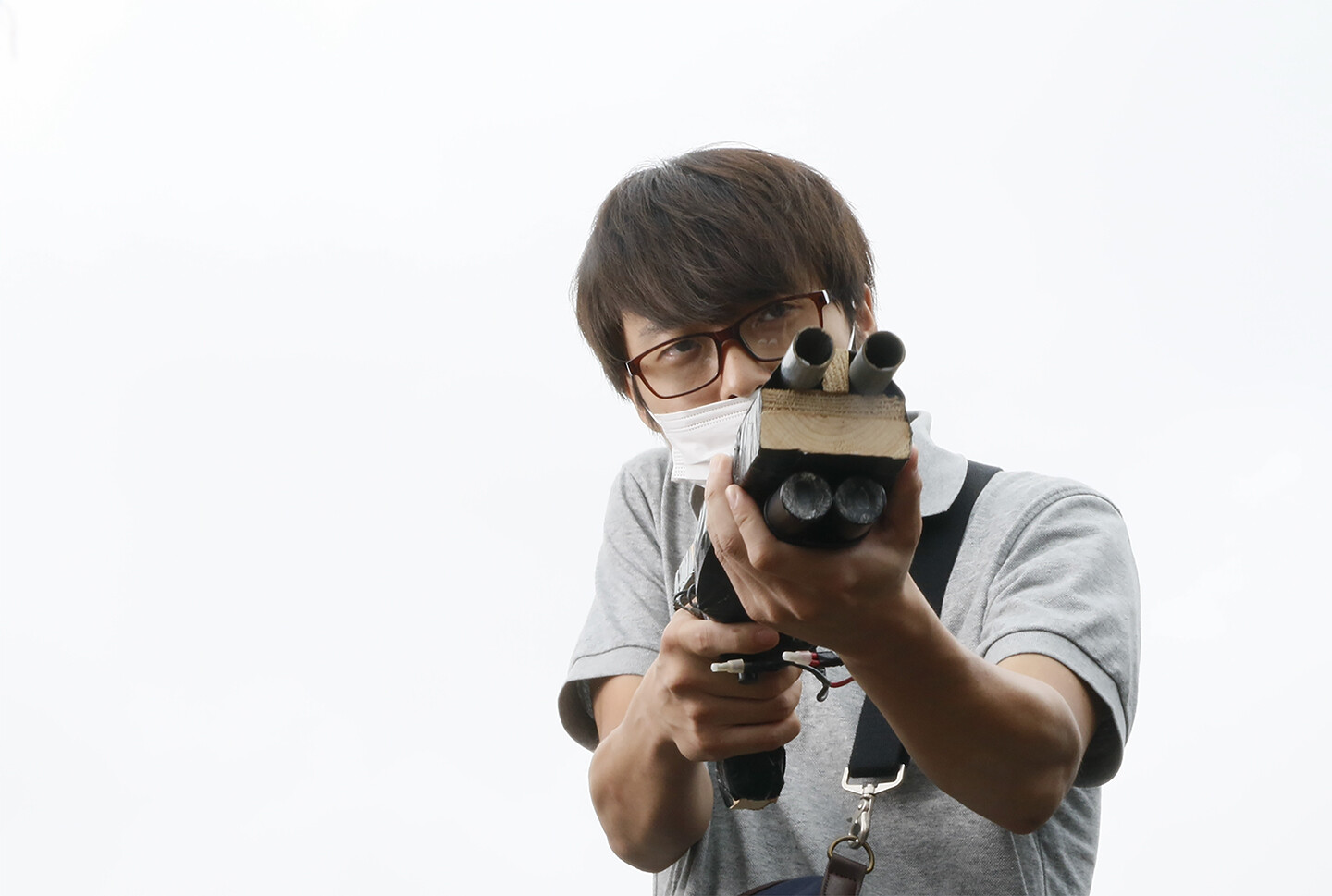This interview with Japanese film director Masao Adachi was conducted in conjunction with the program Landscape Theory: Post-1968 Radical Cinema in Japan, copresented by e-flux Screening Room and the Pratt Institute, March 24–27, 2023.1
After making the experimental films Bowl (1961) and Closed Vagina (1963) with the Nihon University Cinema Club, Masao Adachi joined Koji Wakamatsu’s Wakamatsu Productions as a screenwriter. While writing Wakamatsu’s “pink films” (softcore erotic films), Adachi directed his first commercial feature film, Abortion (1966). During this period, he also worked on screenplays such as Diary of a Shinjuku Thief (1969) and Three Resurrected Drunkards (1968) for Nagisa Oshima, and independently produced his avant-garde feature Galaxy (1967). In 1969, Adachi, film critic Masao Matsuda, and screenwriter Mamoru Sasaki collaborated on the film A.K.A. Serial Killer (1969), consisting solely of the landscapes that nineteen-year-old Norio Nagayama, a serial gun murderer, might have seen during his wanderings. In making this film, they proposed a new visual theory of politics and revolution called “landscape theory,” which attempted to locate the structure of state power not in the political domain, but rather in ordinary everyday landscapes. In 1971 Adachi and Wakamatsu traveled to Lebanon and collaborated with the Japanese Red Army and the Popular Front for the Liberation of Palestine to make Red Army-PFLP Declaration of World War (1971), a newsreel film that was meant to serve as a text for global revolution. Wishing to subvert the conventional approach to film distribution, Adachi and his peers formed the Red Bus Film Screening Troop, screening the film around Europe and Palestine in nontraditional spaces. Spurred on by this undertaking, in 1974 Adachi left Japan for Lebanon, joined the Japanese Red Army, and committed himself to the Palestinian Revolution. He was arrested in Beirut in 1997 and extradited to Japan in 2000. In 2006, he completed his first new film in a quarter century, Prisoner/Terrorist, and followed this with Artist of Fasting (2016). His latest film, REVOLUTION+1 (2022), is about the assassination of former Japanese prime minister Shinzo Abe. This interview was conducted shortly before the international premier of REVOLUTION+1 at Berlin Critics Week in February 2023. It has been edited for length and clarity.
—Go Hirasawa and Ethan Spigland
***
Go Hirasawa and Ethan Spigland: How did you conceive of your new film, REVOLUTION+1 (2022)?
Masao Adachi: When I first heard about former Prime Minister Abe’s assassination, I thought it was an act of political terrorism. As I learned more about the shooter, Tetsuya Yamagami, I came to realize that he did not have any background in organized political action, and was rather freely roused to action by individual concerns. I thought the meaning of this incident was immeasurable. I imagined the hardships that Yamagami must have endured before the shooting. I realized that the state of Japanese politics was imposing a feeling of entrapment on youth. I felt compelled to reveal such circumstances in a film. For context, Yamagami was motivated to commit this act by the criminal actions of the Unification Church, a fraudulent group with ties to Abe that extracts money and assets from individuals and families in the name of religion.2 The key point is that Yamagami acted as an individual executioner who came to his own decision about how to fight against this criminal group, rather than being directed by a political organization or social movement.
GH and ES: The production of REVOLUTION+1 was very fast, which reminds us of how Wakamatsu Productions films were made in the 1960s and ’70s, where films were often scripted, shot, and edited in a matter of days, after which they were promptly screened. Indeed, REVOLUTION+1 was shot by Kenji Takama, who worked as a camera assistant for Wakamatsu in the sixties. Why did you adopt a similar low-budget approach for your new film?


Masao Adachi, A.K.A. Serial Killer, film still, 1969.
MA: With some exceptions—Closed Vagina (1963), Galaxy (1967), A.K.A. Serial Killer (1975), and Red Army/PFLP: Declaration of World War (1971)—my films intended for theaters are usually made on low budgets and shot very quickly, so it’s not unusual. However, in this case, I also felt a sense of urgency to rapidly produce a cinematic expression before the media was able to distort the situation and propagate the shooter’s criminal profile or their version of his grounds for this incident.
Several years ago, on the occasion of the tenth anniversary of Koji Wakamatsu’s death, six directors who made films for Wakamatsu Productions planned to make a series of films in the style of the old “pink films,” but for the present. However, the project was abandoned for various reasons. I had thought about Kenji Takama as one of the directors for that series and asked him to be the cinematographer for REVOLUTION+1.
GH and ES: You made the film soon after the shooting of Abe, and screened the work during his state funeral. Was this an attempt to locate the film within a political and social context? Or do you not endorse that separation between film and politics?
MA: That’s really an important question. My own theory is that films undeniably confront contemporary society. REVOLUTION+1 reflects the political and economic situation of Japan and the world, both of which are heading toward collapse and crisis. Since films only exist to be screened, there is a battle between the imagination of the creator and the viewer. I think this battle expresses the prevailing political situation as faced by both the creator and the viewer. While we were writing the script for REVOLUTION+1, the current prime minister, Fumio Kishida, declared that he would mourn the death of former Prime Minister Abe at his state funeral. I was outraged by this fraudulent attempt to promote Abe as a “great” politician, when he was a political criminal who degraded democracy, which though imperfect at least once existed as a political form and has endured in theory. It should be noted that more than 60 percent of the Japanese population opposed the state funeral.3 As a filmmaker, I felt compelled to express my dissent by screening this film on the exact day of Abe’s funeral, even though the film was unfinished at the time. When I proposed this plan to the cast and crew, they agreed, and so I carried it out. So to answer your question, the intention was to practice a method that transcends the supposed binary between film and politics, revolution and art.
GH and ES: That unfinished cut of the film was screened in Shinjuku on the eve of the state funeral, in Shibuya and Nagoya on the exact day, and in Osaka the next day. How did audiences respond?
MA: As a matter of fact, the film was almost completed by the time we screened it. We made a different version for the screening events. During the editing process, the assistant director and the production team insisted that there should be a live broadcast of the state funeral at the beginning of the event, which would be viewed by the filmmakers, including myself. The pilot version of the film is thus explicitly “against the state funeral.” We held screenings and talks in three cities, where the venues were fully packed. The audiences received the films very well, and there were also very active discussions about Yamagami’s act and motives in relation to the film. This occurred beyond the noisy rabble of the criticism claiming that the film was mere political dogma. Instead, by depicting Yamagami’s motive behind the crime and by having discussions about it, we demonstrated that the nature of the problem in Japan is a political crisis.
After all, the question was, do we approve of Yamagami’s crime, especially its nature as a violent shooting? Yamagami committed the crime because he was desperate, but was there no other solution? I decided to depict a third conclusion that is neither against nor in favor of violence, in order to criticize the tendency of thinking in binary terms that prefigures an instant conclusion. In other words, violence is neither totally negative nor totally positive, but rather something that should be considered on a case-by-case basis. In the end, I chose to depict the contradictions in their entirety, and let the audience come to their own conclusions.
GH and ES: Like your previous two works, the music for REVOLUTION+1 was composed by Otomo Yoshihide. Could you talk about your collaboration?
MA: The script was finished late at night. Without waiting for the morning, I called him and asked him to do the music. Otomo immediately replied with interest and said, “Send me the images and the script.” Two hours later, he said, “I read the script. This is very interesting, I’m in. I already composed the music!” I went to where he was recording music for another film and gave him a couple of images. We recorded the performance right away, and it was done.
GH and ES: Your attempt to screen the film in places other than movie theaters reminds us of the screening campaign for Red Army/PFLP: Declaration of World War, in which you screened the film in nontraditional places. In the theater screenings that began at the end of last year, traditional screenings in Nagoya, Osaka, and Yokohama preceded irregular screenings in Tokyo. I assume there were issues about whether micro-cinemas would screen the film, even though they had emerged from those earlier screening movements of the 1970s and ’80s.
MA: The screening of Red Army/PFLP: Declaration of World War was part of a revolutionary movement that we called the “Red Bus Film Screening Troop.” It was a movement of “screening events” in which the films were shown across the country as a pretext for collective conversations afterwards. The screening event “Against the State Funeral” was similar to that. However, there were some requests from film venues to view REVOLUTION+1 in advance, since the film makes direct political claims. Theaters were cautious since there was the possibility of protest by right-wingers or religious organizations. This is, of course, expected. In order to convince the film venues, I needed to demonstrate that the work would be interesting for general audiences.
GH and ES: What is the significance of the title, REVOLUTION+1?
MA: The main theme of this film is self-determination. How does the protagonist (a fictionalized Yamagami) endure tragedies—his father and brother’s suicides, his mother being trapped by the deception of the fraudulent group that calls itself a religion? Importantly, Yamagami was motivated to act by personal concerns, by asking himself what his true obstacle and who his real enemies were. Unlike crimes that are impulsive and indiscriminate, Yamagami targeted a former prime minister. It was premeditated; he calmly prepared by building a powerful gun and doing target practice. All of these actions fulfill the task of counterattacking the absurdity of hardships, which is the basis for revolution. By interrogating the grounds of personal struggle, there is no need to determine whether this act is an individual “rousing to action” or a revolutionary act by an organized movement.
The “+1” in REVOLUTION+1 demonstrates the inability to think in unequivocal terms. Is this the same as revolution or not? Here, after denying the unequivocalness of “+1,” we came to the solution that we would ask the audience to decide the answer. It also evokes the hope of taking the first step towards a new revolution. Whether violent or peaceful, the desire for revolution has been decaying for quite a while. The necessary solidarity structures for discussion and debate among comrades and communities are no longer present. And so, instead of thinking about popular power, the role of the individual becomes magnified. I depicted the reality of losing this collective momentum towards revolution, showing how the various political and social crises create a situation in which actions can only be thought of in individual terms.
GH and ES: What styles and methodologies did you choose in making this film? In some sense, the film is a docudrama that directly portrays Yamagami’s actions leading up to the assassination. On the other hand, there are many experimental and fictionalized elements: Yamagami’s narration, the pouring rain inside the detention center, the phantom of Yamagami’s brother, the closing sequences in which Yamagami lies in a fetal position in a strange, barren landscape.
MA: As far as method goes, the idea was to explicitly depict the protagonist’s emotional changes in stages. In addition to his actions, we also tried to depict his inner life. As a result, we selected a documentary style, but also stylized scenes, like those in which rain suddenly starts to come down indoors.


Masao Adachi, Bowl, film still, 1961.
GH and ES: In the depictions of rain and fetuses, we can see similarities between REVOLUTION+1 and your previous work, or those works that you wrote and Wakamatsu directed, like The Embryo Hunts In Secret (1966) and Go Go Second Time Virgin (1969), and the looping narrative structures in The Bowl (1961), Galaxy (1967), Prisoner/Terrorist (2007) and Artist of Fasting (2016). The film also reminds us of the protagonist in Sex Jack (1970), insofar as it depicts an anarchist in a different way from usual portrayals of leftists and leftist movements.
MA: I think I always return to a depiction of an individual’s “rousing to action.” Perhaps I am more stubborn than I think, and I projected my desire or self-analysis onto the protagonist’s actions. That is the reason why I consider myself to be an anarchistic surrealist.
GH and ES: In terms of depicting the story of an actual shooter right after the incident took place, REVOLUTION+1 reminded us of A.K.A. Serial Killer. Whereas in A.K.A. Serial Killer we never see the protagonist, only the landscapes he may have observed, in REVOLUTION+1 the protagonist is visible in almost every shot. In addition, the landscapes we do see in REVOLUTION+1 are very homogenous. How do you regard landscape theory these days?4 You already mentioned in 2003 (in a conversation with Takashi Sakai) that landscape has shifted toward the inside, that “the substance of the human being itself has become the landscape.” You suggested that the role of landscape theory has come to an end, since the power of capital to subsume and commodify has become all-powerful. Today, with the evolution of digital and social media, capital penetrates us ever more deeply. Is it still possible to subvert or exceed the landscape, which is now both outside and within us? And do you think films and politics remain appropriate arenas to explore such issues?
MA: In terms of landscape theory, REVOLUTION+1 is an extension and a continuation of A.K.A. Serial Killer, since both stories are about a protagonist who is forced to confront society. But whereas A.K.A. Serial Killer doesn’t depict the protagonist, only the landscapes he might have seen, REVOLUTION+1 follows the protagonist closely and only depicts the landscapes in the background. The films are similar in the way they both are provocative in relation to their time, but they take opposite approaches. And similar to A.K.A. Serial Killer, REVOLUTION+1 emphasizes the process by which the protagonist realizes he is trapped by a wall—a wall of social landscapes that oppressively confront him as hardships. To simultaneously break the wall of his ego and the wall of society is the core of the narrative. REVOLUTION+1 depicts this process until Yamagami commits the shooting as a way of breaking through these walls.
See →.
On the Unification Church, see Justin McCurry, “Japan Begins Inquiry into Unification Church in Wake of Shinzo Abe Killing,” The Guardian, November 22, 2022 →.
Motoko Rich and Ben Dooley, “Why Japan Is Angry About a State Funeral for an Assassinated Leader,” New York Times, September 24, 2022 →.
On landscape theory, see →.


